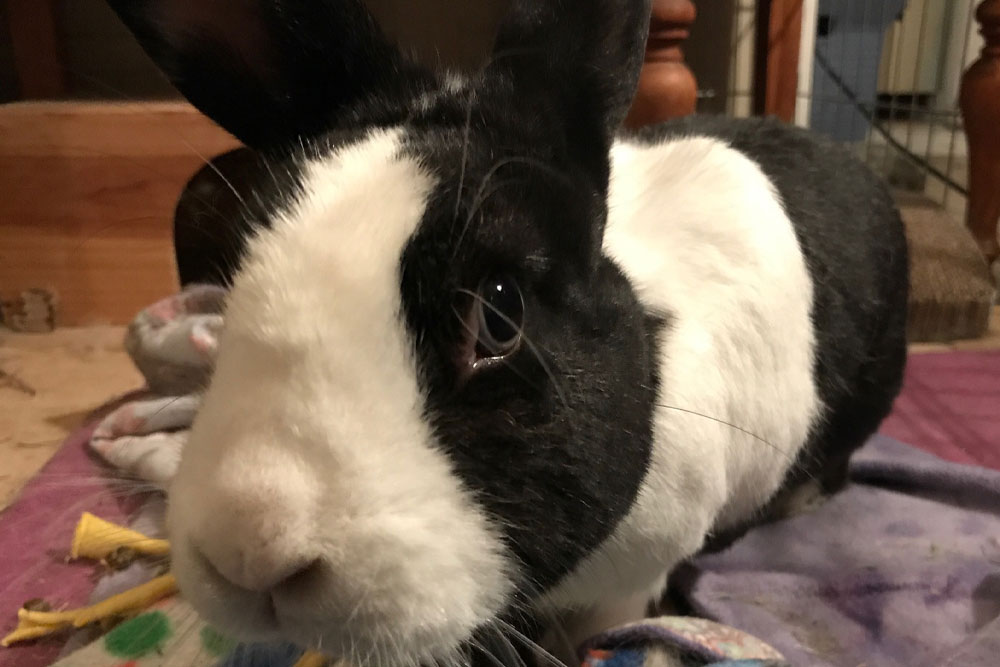“Please eat. Please … You need to eat.”
Humans who live with rabbits quickly learn the four most important signs of rabbit health – eating, pooping, drinking, and peeing. Despite being wise and resilient little beings, they are also fragile animals who hide illness far too well. Gastrointestinal distress is a symptom of one such illness. If the medical crisis is missed, it can even lead to death. It’s a heartbreaking circumstance that can take less than twelve hours to occur.
Eight years ago, I knew none of this. Fortunately, I live in an area with great rabbit rescues. I started volunteering with the Rabbit Haven and House Rabbit Society Headquarters here in Northern California. Both groups help humans learn to be advocates for rabbit care. They also rescue very sick bunnies from public shelters.
Seven years ago, I got a call from Auntie Heather of the Rabbit Haven. A local shelter was requesting urgent rescue for two sick bunnies. Katerina and Jaxon were mother and son. By the time I reached them, Katerina was cold and floppy. Jaxon huddled close to her with a worried look in his eyes. We hustled them into a carrier, and I raced to the emergency vet—heater cranked to the max. The story has a happy ending. With weeks of care and the support of many people, both bunnies recovered and were adopted together into a loving home. But they nearly didn’t make it.
Katerina, like many bunnies in a medical crisis, wasn’t eating and couldn’t maintain her core temperature. Rabbits can develop fevers, but often they go into shock with below normal temperature. Inevitably bunnies seem to do this just when no exotic vets are available. So, Auntie Heather made sure we set up an emergency bed at home. It’s a trick I’ve used countless times since. The set up is flexible. Emergency beds work on the floor, on tables, even on your bed. An emergency bed can help during a crisis.
Step 1: Shelter
If a bunny is cold or in pain, this is the time for one of those too small pet store cages, or even a large carrier. If the doors are tiny, plan to remove the top whenever you need to move the rabbit. Easy access will reduce stress for the bunny and the human.

Step 2: Insulate
Layer thick blankets under and over the entire cage. Leave a gap for fresh air, but not too big—just enough to be safe. The goal is to trap warm air inside the space. Line the inside of the cage with a soft blanket. Keep the space warm and comforting.

Step 3: Heat
The rabbit must be able to move on or off the heat source. Too much heat can cause their temperature to spike. Different types of heating sources can be used. An electric heating pad under one side of the cage works very well and is a nice indirect heat source. (K&H Manufacturing makes a Small Animal Heated Pad that maintains low heat and is safe from biting.) Placing a covered Snuggle Safe inside the cage, or even wrapping tightly closed bottles of hot water in a towel also can work.
Side note: It’s best to have a veterinarian teach you how to safely check a bunny’s core temperature and determine the normal temperature range for your rabbit. But if the rabbit feels cold to the touch, holding the bunny wrapped in a warm electric heating pad or hot towels from the dryer is another good technique. Watch the rabbit closely for signs of discomfort whenever using heat. Monitor closely to make sure the bunny doesn’t get too hot.

Step 4: Feed
Leave lots of yummy choices in the emergency bed—wet leafy greens, different hays (especially alfalfa and oat), pellets, a small piece of fruit, favorite treats—anything that might entice the rabbit to eat. This is not a standard diet for rabbits. Too many rich foods can quickly create other issues. But during an emergency, the goal is to keep the bunny warm and relaxed and to get them to start eating and drinking again. As soon as possible, work with a professional to determine what the rabbit needs.

Step 5: Veterinary Care
If you can’t immediately reach a vet, write down everything you notice and do, noting the date and time. Call your vet clinic as soon as they open to let them know you have a sick bunny. There is no replacement for medical care, especially if your rabbit has a serious condition.
Get veterinary care as soon as possible. Building a good relationship with a veterinary clinic is something to do before your bunny needs help. If your community isn’t blessed with veterinarians who work regularly with rabbits, find a support network. Reach out to national rabbit rescue groups to learn about good medical care, and then develop a relationship with a local vet who is willing to learn. Learning how to safely support a sick bunny is something anyone can do. It can be stressful, but when your bunny feels better—it will all be worth it.
Reviewed by HRS staff
Author: Sarah Camp
Photo Credit: Sarah Camp
Journal Issue: House Rabbit Journal, Winter 2020
Sign up to Our Newsletter!
Sign up for web update alerts and our monthly e-newsletter
to stay current on HRS, our Chapters, and info for your bunny.




